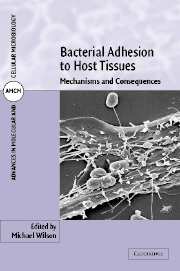Book contents
- Frontmatter
- Contents
- List of contributors
- Preface
- Part I Bacterial adhesins and adhesive structures
- Part II Effect of adhesion on bacterial structure and function
- 7 Transcriptional regulation of meningococcal gene expression upon adhesion to target cells
- 8 Induction of protein secretion by Yersinia enterocolitica through contact with eukaryotic cells
- 9 Functional modulation of pathogenic bacteria upon contact with host target cells
- Part III Consequences of bacterial adhesion for the host
- Index
- Plate section
8 - Induction of protein secretion by Yersinia enterocolitica through contact with eukaryotic cells
Published online by Cambridge University Press: 08 October 2009
- Frontmatter
- Contents
- List of contributors
- Preface
- Part I Bacterial adhesins and adhesive structures
- Part II Effect of adhesion on bacterial structure and function
- 7 Transcriptional regulation of meningococcal gene expression upon adhesion to target cells
- 8 Induction of protein secretion by Yersinia enterocolitica through contact with eukaryotic cells
- 9 Functional modulation of pathogenic bacteria upon contact with host target cells
- Part III Consequences of bacterial adhesion for the host
- Index
- Plate section
Summary
INTRODUCTION
Contact-dependent secretion pathways, also known as type III secretion pathways, have been identified in a large number of animal and plant pathogenic bacteria (Van Gijsegem et al., 1993; Cornelis and Van Gijsegem, 2000). The designation ‘contact dependent’ comes from the observation that proteins are secreted from bacteria after they contact their particular eukaryotic cell target (Ginocchio et al., 1994; Ménard et al., 1994; Rosqvist et al., 1994; Wolff et al., 1998; Vallis et al., 1999; van Dijk et al., 1999). The name type III differentiates this secretion pathway from the four other secretion pathways that have been identified thus far in Gram-negative bacteria (for recent reviews, see Henderson et al., 1998; Wandersman, 1998; Burns, 1999; Stathopoulos et al., 2000; Thanassi and Hultgren, 2000;). Many of the components of the type III secretion pathways of Gram-negative bacteria resemble components of the flagellar assembly apparatus found in these same organisms (Minamino and Macnab, 1999; Bennett and Hughes, 2000).
Yersinia enterocolitica, a pathogen of a variety of mammals, has three apparently independent type III secretion pathways that are involved in virulence. The best studied of these (and probably the best-studied type III secretion pathway in all bacteria), the plasmid-encoded Ysc secretion pathway, is found in all three pathogenic species of Yersinia – Y. enterocolitica, Y. pestis and Y. pseudotuberculosis (for a review, see Cornelis and Van Gijsegem, 2000). This contact-dependent secretion pathway is involved in the secretion of 11 proteins, termed Yops, most of which are translocated into host cells, where they alter host cell functions, resulting in the inhibition of antimicrobial activities of phagocytic cells (for a review, see Cornelis, 2000).
- Type
- Chapter
- Information
- Bacterial Adhesion to Host TissuesMechanisms and Consequences, pp. 183 - 202Publisher: Cambridge University PressPrint publication year: 2002
- 1
- Cited by



